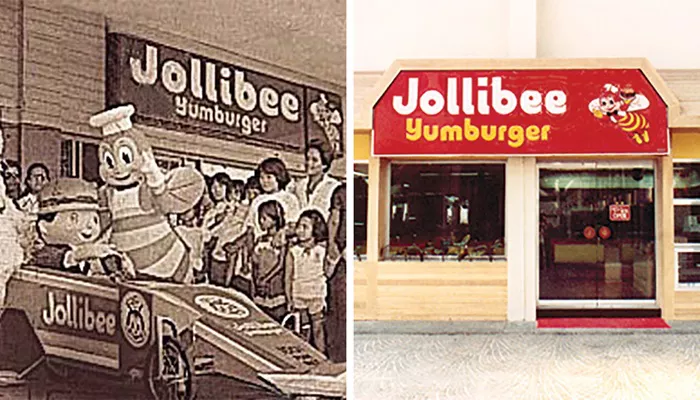In 1975, Tony Tan Caktiong and his family embarked on a modest venture by opening a Magnolia ice cream parlor in Cubao, Quezon City. This establishment served as the foundation for what would eventually become Jollibee. Initially, the focus was on selling ice cream, but as time passed, the demand for hot meals grew. Recognizing this shift, the family decided to pivot their business model.
By 1978, the ice cream parlor was transformed into a fast-food restaurant, marking the official birth of Jollibee. The name “Jollibee” was derived from “jolly” and “bee,” symbolizing a fun and friendly dining experience. The first Jollibee outlet was strategically located near the Coronet Theater, making it accessible to a large number of customers.
The First Store: A Landmark in Fast Food
The first Jollibee store opened in June 1978 at Coronet Theater in Cubao, Quezon City. This location quickly became a popular hangout for families and friends, offering a menu that featured not only hamburgers but also Filipino favorites. The initial offerings included the Yumburger, a signature hamburger, and the Jolly Spaghetti, a sweet and savory dish that has become a staple in Filipino cuisine.
The success of the first store can be attributed to its unique menu that catered to Filipino tastes. While other fast-food chains focused primarily on American-style offerings, Jollibee introduced a blend of Western fast food with local flavors.
This strategy resonated with the Filipino market, leading to rapid growth.
Expansion And Growth
By the end of 1978, Jollibee had expanded to seven branches within Metro Manila. The brand’s growth was fueled by its ability to adapt and innovate. In 1979, Jollibee began franchising, which allowed it to reach more customers across the Philippines. The first franchised outlet opened in Santa Cruz, Manila, further solidifying Jollibee’s presence in the fast-food sector.
Throughout the 1980s, Jollibee faced competition from international brands such as McDonald’s. However, it managed to maintain its market share by focusing on the unique preferences of Filipino consumers. The introduction of Chickenjoy, a crispy fried chicken meal, in the 1980s further solidified Jollibee’s reputation as a leader in the fast-food industry.
SEE ALSO: How Much Net Profit Does A Mcdonald’s Franchise Make
A Cultural Icon
Jollibee has transcended its role as a fast-food chain to become a cultural icon in the Philippines. The brand’s mascot, Jollibee, is a beloved figure, often featured in advertisements and promotional events. The cheerful bee symbolizes joy and happiness, aligning perfectly with the brand’s mission to bring joy to every meal.
The company has also embraced Filipino traditions and values, incorporating them into its marketing strategies. Jollibee’s advertisements often highlight family bonding, celebrations, and the importance of community, resonating deeply with its target audience.
International Expansion
Jollibee’s success in the Philippines paved the way for its international expansion. The first overseas outlet opened in Singapore in 1985, although it faced challenges and closed after a year. Undeterred, Jollibee re-entered the Singapore market in 2013, and since then, it has successfully established a presence in various countries, including the United States, Canada, and the Middle East.
As of 2024, Jollibee operates over 1,500 stores worldwide, with a significant number located in the Philippines and a growing presence in international markets. The brand’s ability to adapt its menu to local tastes has been a key factor in its success abroad.
The Menu: A Fusion of Flavors
Jollibee’s menu is a testament to its commitment to offering a unique dining experience. The combination of American fast food and Filipino flavors has resulted in a diverse menu that appeals to a wide range of customers. Some of the most popular items include:
Chickenjoy: A crispy fried chicken meal served with rice and gravy, known for its juicy and flavorful meat.
Yumburger: A classic hamburger that has been a staple since the early days of Jollibee.
Jolly Spaghetti: A sweet Filipino-style spaghetti dish that features a rich tomato sauce, sliced hot dogs, and cheese.
Burger Steak: A savory dish that includes burger patties served with mushroom gravy and rice.
In addition to these signature items, Jollibee continuously innovates its menu by introducing limited-time offerings and localized products in international markets.
Community Engagement And Corporate Social Responsibility
Jollibee’s success is not solely attributed to its delicious food; the brand is also known for its commitment to social responsi
bility. The Jollibee Group Foundation, established in 2004, focuses on various initiatives, including education, disaster relief, and community development.
The foundation’s programs aim to uplift communities and support underprivileged children, aligning with Jollibee’s mission to bring joy to every meal. Through these efforts, Jollibee has solidified its reputation as a socially responsible brand that cares for its customers and communities.
Conclusion
The first Jollibee store in Cubao, Quezon City, holds a special place in the hearts of many Filipinos. It represents the beginning of a journey that has transformed a small ice cream parlor into a global fast-food giant. Jollibee’s ability to adapt, innovate, and connect with its customers has been instrumental in its success.

